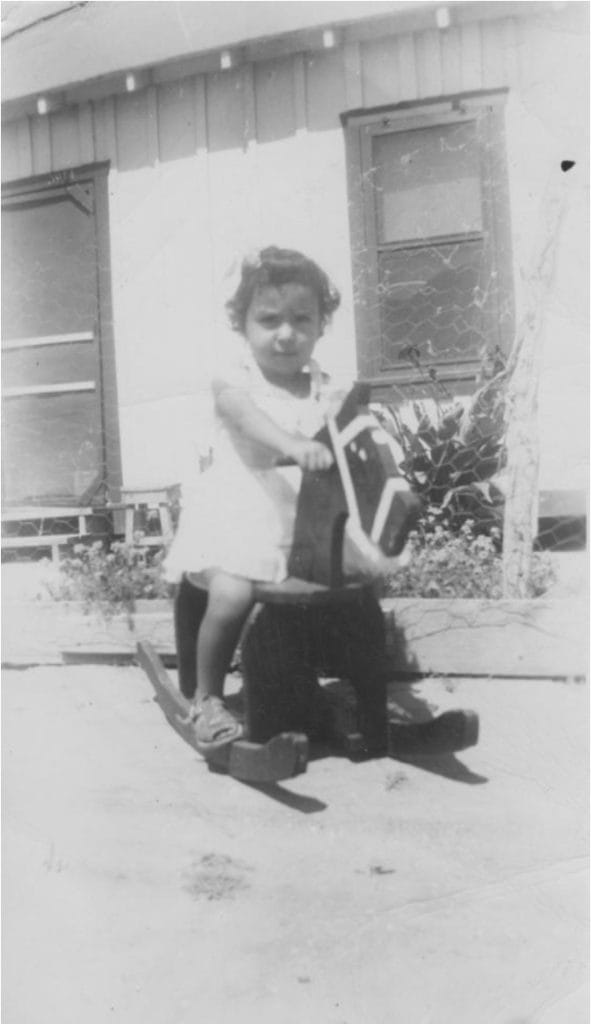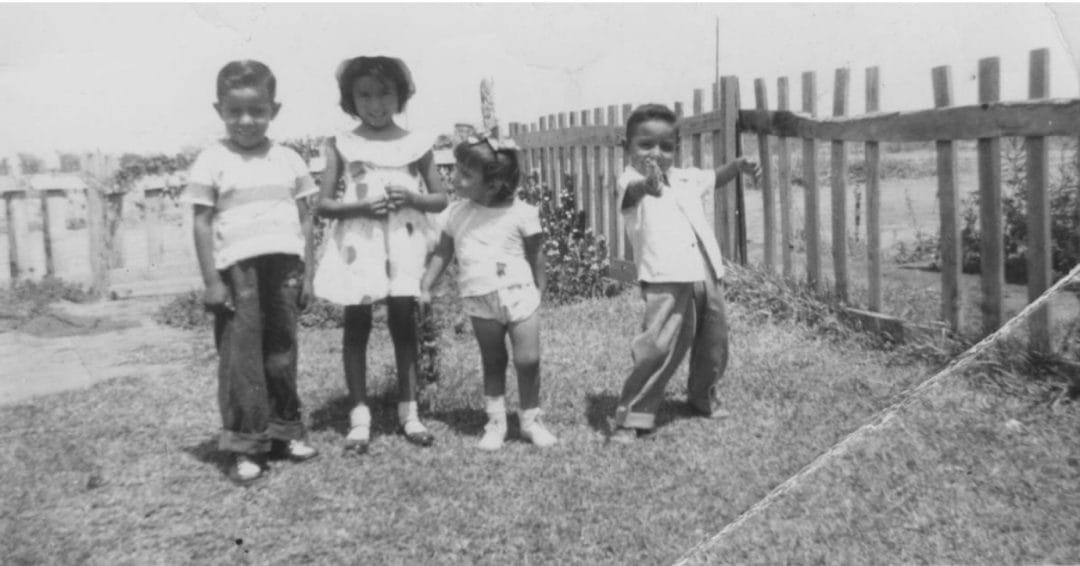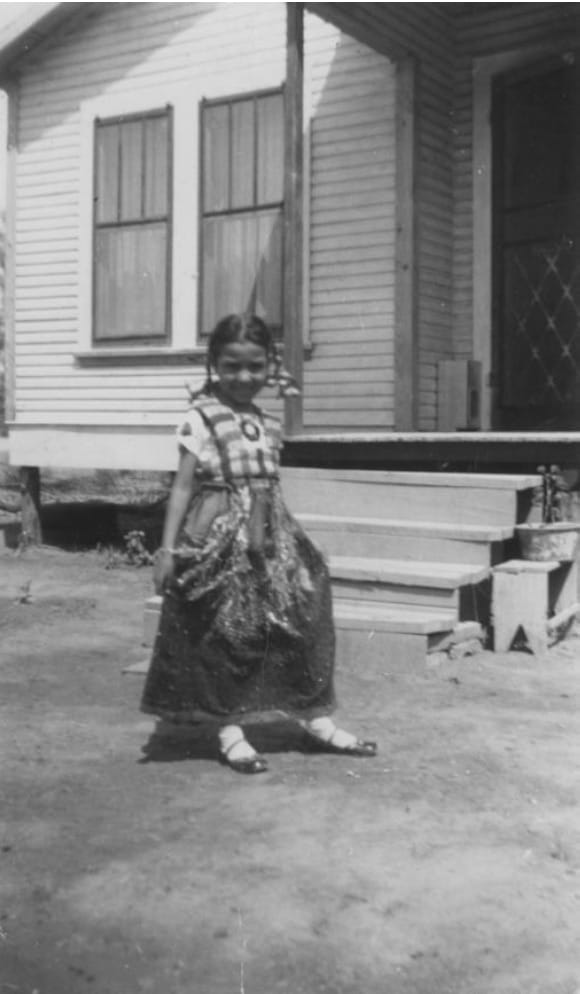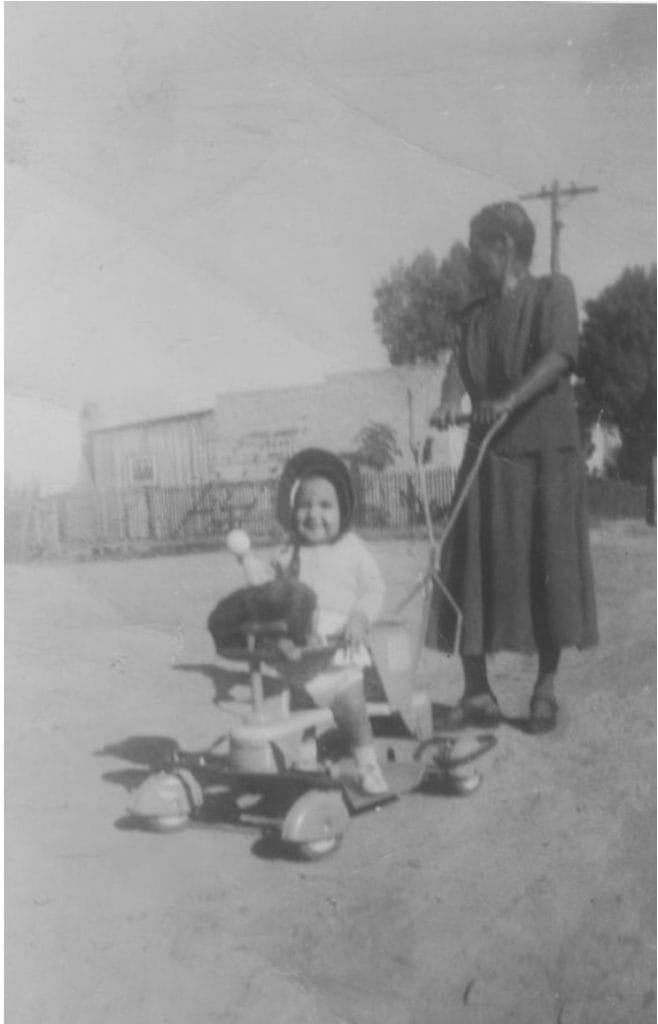
Rocking Horse
I ride the rocking horse Buelito’s built from discarded wood planks, painted the color of the red coyoles—red as memories. My feet sandaled in brown huaraches from Nuevo Laredo with tiny green nopales and the tinier red pears, tunas, painted on the delicate leather. A white ribbon holds flimsy black curls away from my face; wisps of rebellious curls escape. Mami has made my sundress, blue like the sky, and embroidered tiny pink rosebuds on the handmade smocking just like the ones she made when she worked as a seamstress at the dress factory. I wear a serious face; riding a horse is serious business at age two. Even as I squint in the noontime sun, I look straight at the camera at Mami who’s kneeling on one knee to be at eye level with me. The screened front door and the window of the house on San Francisco Street where Tino was born frames us, me and my red horse. Blood-red verbena on the ground, tall-leaf coyoles bloom red in the background. The ride’s bumpy on the gravel front yard, but I hold on as tight as if I were riding the real pony I long for—the sad-looking pinto that we ride round and round at the carnival. Because I’m the oldest, I am the beneficiary of Buelito’s carpentry skills; he makes toys from wooden spools and toothpicks and rubber bands. Later, when we live on Santa María, the same year Dahlia is born, he’ll build a tiny table and chair for me and my dolls. There I’ll sit and drink Choco Milk and eat galletas marías when I come home from Señora Piña’s escuelita where I learn to count and sing and declamar poems for Mother’s Day: “Si vieras mamita, que lindas flores / amarillas y azules / de mil colores / aquí las veo abiertas / acá en botón / pero todas alegran mi corazón” and “Un lunes por la mañana me decía mi mamá / levántate, Azucena, si no le digo a tu papá / y yo siendo una niña de carta cabal / me quedaba calladita / ‘¿Qué no me oyes, lucero?’ / ¿Lucero? ¡Si ni candil soy!” Buelito, who is sometimes gone, has come to be with us for a while. I ride a red rocking horse to the rhythm of lullabyes, look at Mami, and suddenly cry. My tears are round stains on the smock of the pinafore, a darker shade of blue.

Tino
He did it at four. And again at nine. He stands to the side with his hand out as if pointing a gun or a rifle. Everyone else is crowded around me; the piñata in the shape of a birthday cake sways in the wind above our heads. Everyone’s there: aunts, uncles, cousins, the neighbors, my madrina, everyone, even Mamagrande Lupita from Monterrey. I’m holding the stick decorated with red, blue, yellow tissue paper that we will use to break the piñata. And he’s playing, even in the picture, at being a soldier. Only ten years later, 1968, he is a soldier, and it’s not a game. And we are gathered again: tías, tíos, cousins, comadres, neighbors, everyone, even Mamagrande Lupita from Monterrey, and Papi’s Cousin Ricardo who has escorted the body home. We have all gathered around a flag-draped coffin. Tino’s come home from Vietnam. My brother. The sound of the trumpet caresses our hearts and Mami’s gentle sobbing sways in the cool wind of March.

China Poblana One
Smiling, I look straight at the camera; I grimace, smile, squint under bright sun. Must be around noon—not a shadow shows. We have just returned from the George Washington’s birthday parade. I hold up my china poblana skirt and point my toe as I stand for the photo. Mami has braided my shoulder-long hair, adding volume and length with yarn—green, white, and red—verde, blanco y colorado, la bandera del soldado. The dazzlingly white blouse embroidered with bright silk to shape flowers like the ones that grow in our yard—roses, hibiscus, geraniums, and even some that look like the tiny blossoms of the moss roses remind me of summer, although it’s a warm February day.
I know Raúl is hiding behind his dad’s car to make fun of me; I pretend not to notice. Instead of his teasing though, I hear a whistle—a wolf whistle—and I become even more upset than if he had called me skinny or wetback, yelled his favorite taunts, “mojada” or “flaca.” I mustn’t move because Mami wants me to stand perfectly still until she takes the picture. I resist the urge to grab a stone, hit Raúl with it. My aim is good and I know exactly where he is, if only I could. And I feel like the Chalupa in the lotería game, like María Félix, Dolores del Río, a movie star frozen in costume. But then it’s all gone like the dust remolino that came up unexpectedly and left us all dusty. A lonely urraca lets out a loud cawing in the noon heat, predicting a change of weather, warning of the freezing winds that will hit later that afternoon and will cut into my face as I ride the wheel of fortune at the carnival, where I’ll bite into pink fluff of sugar and find it disappear into sweetness. We go inside the frame house, have lunch: sopa de arroz, picadillo guisado, and fresh corn tortillas with orange-flavored Kool-Aid. Mami tells Bueli that I’m growing so fast the costume won’t fit by next year, and Dahlia will wear it to the parade. I cringe and want to cry, but I won’t let the thought spoil the present, and I ask: can I buy cotton candy at the carnival? Maybe I’ll even win a little pink or blue chick to keep me company. And I do but when the chick becomes a chicken, Bueli wrings its neck, drains the blood, and we have arroz con pollo for Easter.

Blue Stroller
I’m in the stroller that I suspect came with us from the other Laredo. A young Bueli is pushing it, dressed in her late-forties platform shoes and tailored dress, her hair up in a chignon. My memory for everything but the stroller is like the photo, black and white; the stroller is the blue of my winter coat when I was sixteen. When I saw the coat on the rack at J.C. Penney’s, I had to have it. Spent almost all I’d earned proofreading for the weekly community paper on that coat. Years later I realized it reminded me of that stroller. Painted blue, made of metal and wood. I remember it well; we used it until Margie was born. Just like my periquera—the fancy high chair that could be converted into a toy wagon, and the crib that rocked like a cradle that Papi repainted and redecorated with bunnies, cubs, kittens, and other baby animal decals for each birth; things were used and reused. Children’s furniture and other pieces, too, as when Papi’s old desk became our desk. It held his old books and magazines, correspondence courses: electrician, magician, even auto mechanic. Dreams of what he’d wanted to be. And some adult joke books that were hidden away from prying eyes—mine. He emptied it of his things, painted it red for Tino’s school things. In the photo, I’m an infant—chubby, puffy cheeks, and under a hat, little hair—oblivious to what is going on, more interested in playing with a rattle, with the red, yellow, green, and blue wooden balls strung on a wire. Mami, a young woman, takes the photo, nineteen when I was born; does she see herself ten years and five children later? Twenty years from then, ten children later?
Norma Cantú’s memoir pre-writing exercise for high school and university students:
Ask students to think of a photo of themselves between the ages of 5 and 12.
Answer the questions:
• Who is taking the photo? A family member? A professional photographer?
• What is the occasion? School photo? Birthday or graduation? Or no special event?
• What are you wearing? Be specific, what color? Fabric?
• What does your hair look like?
• What shoes are you wearing?
• What sounds do you recall? Smells?
• Who else is in the photo?
• If you could talk to the you in the photo what would you say?
• If the you in the photo could talk to you what would they say?
Norma Elia Cantú is the Norine R. and T. Frank Murchison Distinguished Professor of the Humanities at Trinity University in San Antonio, Texas.
